June 2024 / EQUITY
The quality factor: Its impact, foundation, and evolution
Secular components have become an important part of quality investing.
Key Insights
- Quality has been a powerful driver of returns, in part, given its relationship to the consistency and compounding of shareholder returns.
- An assessment of quality should center on financial analysis to help understand corporate health; financial productivity; and a company’s competitiveness, management execution, and shareholder returns.
- Quality is increasingly being influenced by a company’s exposure to secular change. Companies aligned with long‑term, sustainable growth trends appear to be economically more resilient and fundamentally of higher quality.
The investment landscape of the last 18 months has been unusual in many respects. Looking back, much of the rally has been driven by risk aversion easing back as black swan events were either avoided or diluted in probability. But while headline equity market returns might imply a robust economic backdrop, index returns were achieved despite an economic deceleration—but also because of a heavy concentration in a handful of stocks, most notably, the “Magnificent Seven”1 (Figure 1). While these stocks might be loosely bonded by the emerging theme of artificial intelligence (AI) and its infrastructure and future applications, the extreme return concentration over that period merits deeper consideration.
Magnificent Seven ride to the rescue
(Fig. 1) 2023 market returns were dominated by a handful of stocks
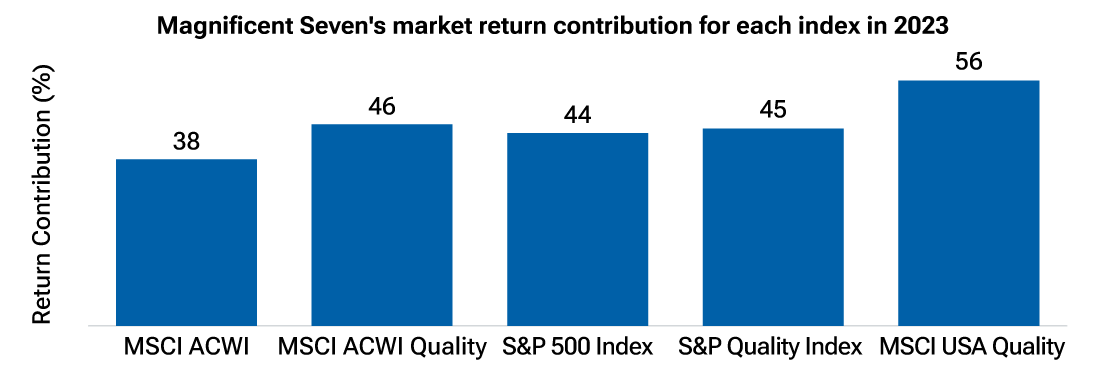
As of December 31, 2023.
Past performance is not a reliable indicator of future performance.
Source: Financial data and analytics provider FactSet. Copyright 2024 FactSet.
All Rights Reserved.
The market capitalization of the Magnificent Seven stocks is one clear linkage, but a key thread when looking at equity returns over the past decade has been a collective improvement in the quality of these companies. This show of quality intertwined with the expectation of future growth and improvement, and stemming from the AI revolution, is at the heart of why these companies have dominated equity returns.
What is quality, and does it work?
Factor definitions—including size, momentum, volatility, growth, and value—have long been viewed with a high degree of consensus among practitioners and academic researchers. While there are variations in the precise metrics used for definition, many factor concepts are widely accepted and understood by investors.
Quality, either as a factor or as an investing style, is a notion that lacks a universally agreed‑upon definition, however. This makes quality harder to identify and capture, despite strong consensus and evidence that it has strong linkages to financial returns within equity markets.
We examined quality from both a quantitative and qualitative perspective with a goal to understand its foundations, its impact on returns, and its redistribution in an ever‑increasing digital world. As a starting point to understand why quality is a much‑debated concept, we compared the MSCI ACWI2 with the MSCI ACWI Quality (Figure 2). While there are many definitions available, the MSCI ACWI Quality aims to capture the performance of quality‑growth stocks by identifying securities with high quality scores based on three main fundamental variables: high return on equity (ROE), earnings stability, and low financial leverage.3
Quality stocks have outperformed for over 10 years
(Fig. 2) The last few years have seen a clear differentiator in performance of quality assets
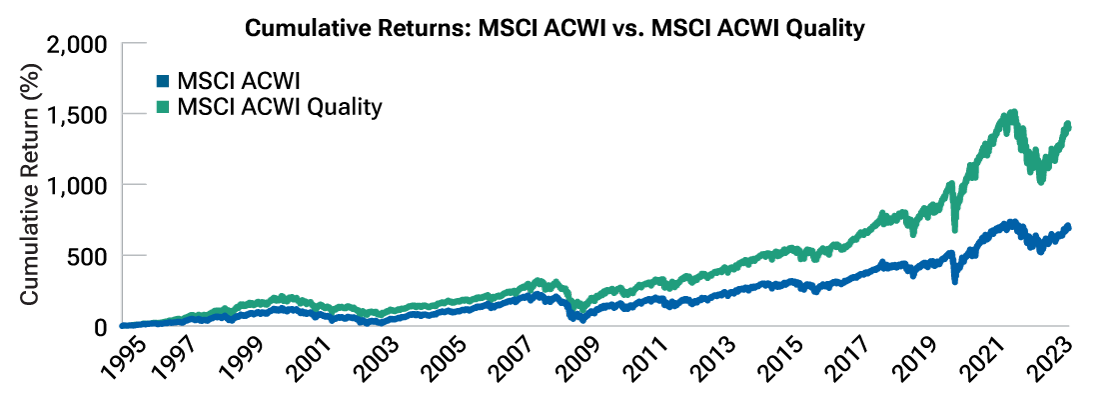
As of December 31, 2023.
Past performance is not a reliable indicator of future performance.
Sources: Financial data and analytics provider FactSet. Copyright 2024 FactSet.
All Rights Reserved. The findings here are universe‑specific to MSCI ACWI and MSCI ACWI Quality.
Outperformance of the quality index is notable, even more so when considering the five‑year rolling relative return of the quality index, which exceeds its mainstream equivalent in 85% of observations since 1997 (Figure 3). At least through the lens of one index definition, quality has been a consistent outperformer, albeit with cyclicality and notable periods of drawdown.
Long‑term outperformance of quality assets
(Fig. 3) Five‑year rolling relative returns of the quality index have exceeded its mainstream equivalent in 85% of observations since 1997
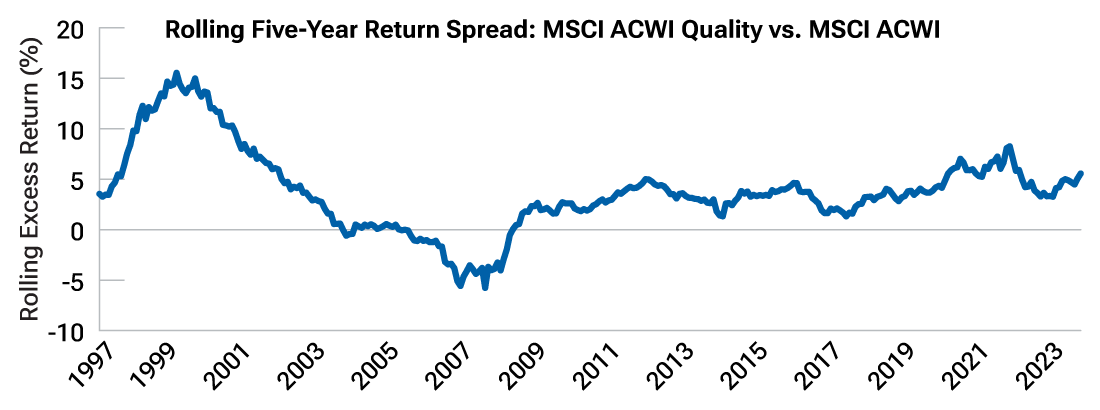
As of December 31, 2023.
Past performance is not a reliable indicator of future performance.
Source: Bloomberg Finance L.P. Monthly returns.
This cyclicality is better observed through an evaluation of shorter‑term data. In Figure 4, we show the same analysis over a rolling six‑month time frame, observing that the quality index often experienced underperformance during extreme risk‑on periods. These have often followed in the wake of crisis‑type events. This pattern is intuitive given that such recovery periods are often defined by broad‑based improvement and high‑risk tolerance. The exit from the financial crisis of 2008–2009 and the reopening of the global economy following the COVID‑19 pandemic are two such examples of quality underperformance.
Risk attitudes define quality asset cycles
(Fig. 4) Quality often experiences underperformance during extreme risk‑on periods
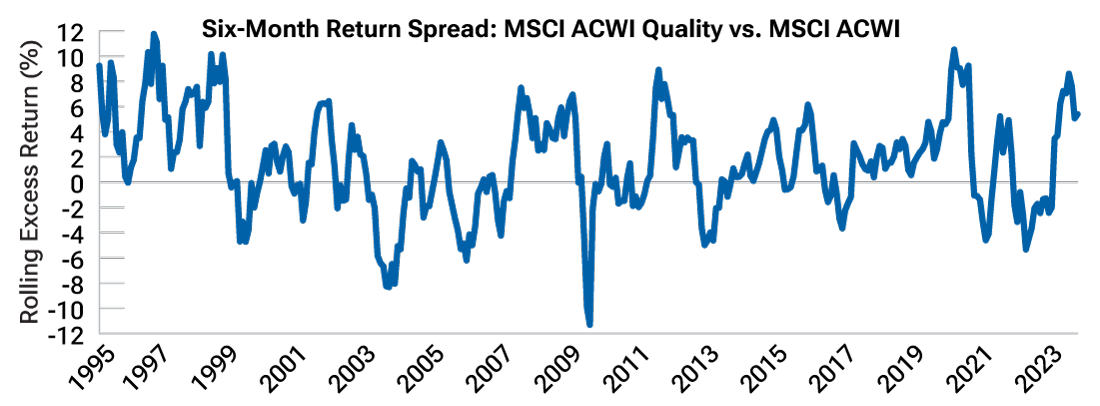
As of December 31, 2023.
Past performance is not a reliable indicator of future performance.
Source: Bloomberg Finance L.P.
With each observation representing six‑month periods rolled one month forward, we found that in 65% of observations, the MSCI ACWI Quality produced positive excess return relative to the MSCI ACWI. Midcycle and/or less directional markets are where quality tends to deliver a return advantage, especially where a scarcity component emerges. This growth scarcity was evident in 2023, and also in the period preceding the pandemic, where economic and earnings growth were muted. As with any scarce commodity, as growth becomes harder to come by, investors are more willing to pay a premium.
The more recent outperformance of quality has been driven by the absence of broad economic and earnings growth, in tandem with a concentration of earnings growth centered on the Magnificent Seven (Figure 5), a group of stocks that has risen in significance for quality investors.
Robust reasons for outperformance of the Magnificent Seven
(Fig. 5) Since the pandemic, earnings growth has been markedly better than for other styles
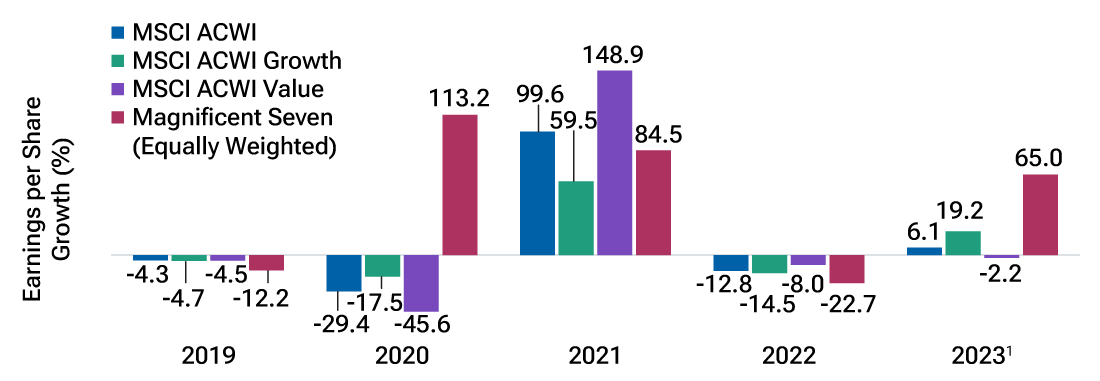
As of December 31, 2023.
1 2023 consensus estimates. Actual outcomes may differ materially from estimates. Estimates are subject to change.
Sources: Financial data and analytics provider FactSet. Copyright 2024 FactSet.
All Rights Reserved. T. Rowe Price.
The foundations of quality
We believe there is no static definition to fully isolate “quality” given the constant evolution of economic, secular, and competitive factors that drive change within sectors and across equity cycles. While quality (alongside value and growth) is evolutionary, it is nevertheless critical to evaluate where stock fundamentals imply dimensions of quality and how this may have strong efficacy for future returns.
To demonstrate this point, we focused on the history of U.S. equity markets by evaluating the long‑term compounded returns of the S&P 1500 Index4 (sector neutral) since 1985. Our approach aimed to give a perspective on the importance of capturing the correct definition of quality and how investors reward differing capital allocation decisions, including reinvestment for future growth, versus the return of capital via dividends.
We grouped potential characteristics into the following two broad groups using sector neutral quintile analysis.
Profitability measures and economic efficacy
One of the pillars of quality focuses on profitability metrics and measures of economic productivity, including return on equity and return on invested capital (ROIC). Considering the S&P 1500 on a sector neutral basis since 1985, we found that companies with high cash flow yield had been the dominant driver of returns within measures of profitability and financial productivity.
High ROE, ROIC, and return on assets (ROA) also appeared to perform well, albeit profit margin indicators do not appear to have strong efficacy on a standalone basis (Figure 6). This provides insight into how investors prefer the singular measure of corporate economic success that cannot be materially influenced by accounting practices—free cash flow.
Companies with higher ROE, ROIC, and ROA tended to shine
(Fig. 6) Companies with high free cash flow performed best
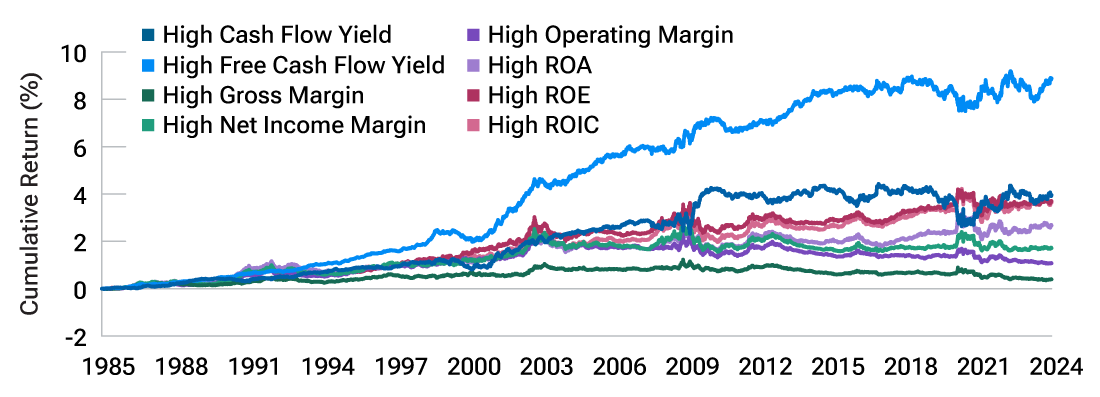
As of December 31, 2023.
Past performance is not a reliable indicator of future performance.
Calculations are based on trailing 12‑months. This chart reflects the profitability and financial productivity measurements for the S&P 1500 Index.Where the term “high” appears in the legend of Figures 6 and 7, we imply (Quintile 1–Quintile 5), conversely, where the term “low” precedes the factor name we imply (Quintile 5–Quintile 1). In terms of factor performance of (Q1–Q5) – High minus Low and or (Q5–Q1) – Low minus High . The process involves analyzing the performance of stock baskets based on factors (Q1–Q5) or (Q5–Q1), which are created by grouping stocks within sectors and adjusting for sector bias/ i.e. sector neutral. Stocks within each sector are ranked based on factor values and divided into quintile baskets. These baskets are then aggregated across sectors to form the final baskets for the entire universe. This approach aims to ensure a balanced distribution across sectors within each factor basket, mirroring the sector. Quintiles are reconstituted monthly. Further information on factor definition can be provided on request. Sources: T. Rowe Price, Piper Sandler.
Leverage and debt service
Another component of quality often cited in quantitative and fundamental literature centers on low or sustainable corporate leverage. While leverage and balance sheet sustainability influence the assessment of quality characteristics and corporate outcomes, including free cash flow generation, leverage alone is not sufficient to capture a full perspective on quality.
High debt coverage and interest coverage are far better predictors of prospective returns over the long term versus low or absolute measures of leverage (Figure 7). This perspective links closely to the performance of companies that are defined by debt sustainability, especially through crises—financial or otherwise— and the preparedness of balance sheets for changes in financing conditions, as we saw in 2023.
Quality companies with high debt coverage can be good predictors of returns
(Fig. 7) Companies with high debt and interest coverage outperformed companies with low absolute measures of leverage

As of December 31, 2023.
Past performance is not a reliable indicator of future performance.
Calculations are based on trailing 12‑months. Where the term “high” appears in the legend of Figures 6 and 7, we imply (Quintile 1–Quintile 5), conversely, where the term ”low” precedes the factor name we imply (Quintile 5–Quintile 1). Quintiles are reconstituted monthly. S&P 1500 is the universe of companies.
Sources: T. Rowe Price, Piper Sandler.
While robust fundamental analysis would always incorporate an assessment of a company’s balance sheet and profitability, one clear observation is the potential tailwind that exists when focusing a portfolio on companies with high quality markers. Another way to look at the data is to consider the hit rate of individual factors by analyzing the frequency of outperformance. While affirming the benefits of high free cash flow and debt sustainability, Figure 8 demonstrates that negative earnings, sales volatility, and high levels of debt to equity were headwinds to return generation. This is intuitive given the drawdown that such stocks experienced during times of economic or industry‑specific downturn or stress.
Free cash flow yield is key
(Fig. 8) Stocks with negative earnings and lower debt to equity have underperformed
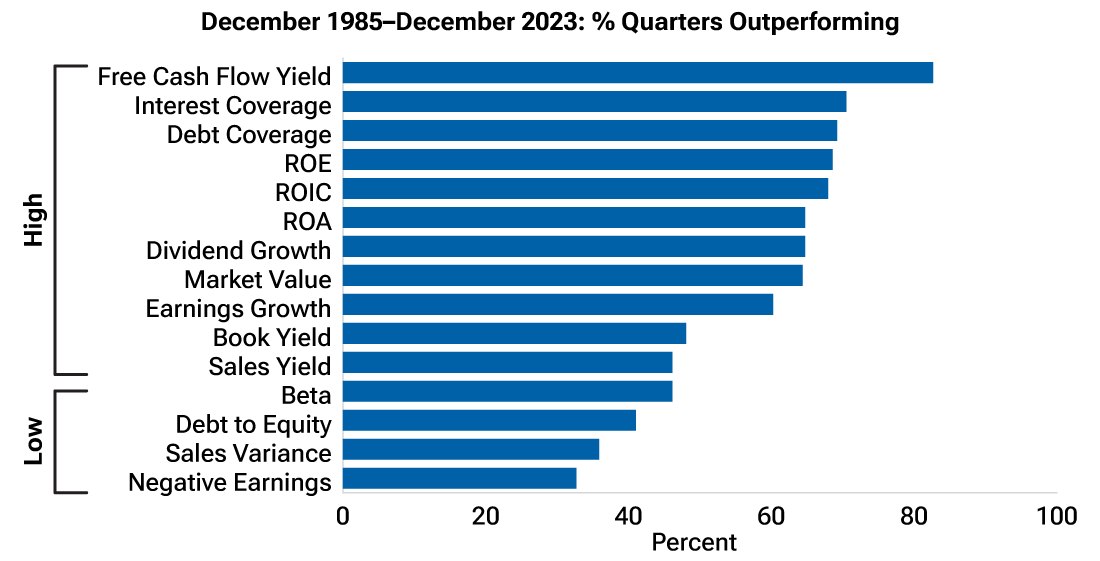
As of December 31, 2023.
Past performance is not a reliable indicator of future performance.
Negative Earnings are companies which have negative earnings. i.e. <0, they are running a net loss. Sales Variance using a 4‑Year Variance in Year‑over‑Year for trailing 12 months sales growth.Performance spread hit rate is measured by quintiles (Quintile 1 outperforms Quintile 5) for “High” and Quintile 5 outperforms Quintile 1 for “Low.” These are measured on rolling 3month periods – i.e. each period represents a 3 month window which is rolled forward 1 month for every observation. Beta, debt to equity, sales variance and negative earnings are all “low” (Quintile 5–Quintile 1) factors; all other factors in the chart are “high” (Quintile 1–Quintile 5). The quintiles are reconstituted monthly. S&P 1500 is the universe of companies.
Sources: T. Rowe Price, Piper Sandler.
The Magnificent Seven and evolution of quality
The investment landscape of the last year and a half has been unusual in many respects. Despite strong headline equity returns, a complex macroeconomic backdrop persisted throughout the year encompassing:
- Extreme and unpredictable inflation
- Heightened geopolitical tensions
- Bank failures, albeit without any meaningful credit or unemployment cycle
- Anemic global economic and earnings growth—excluding the Magnificent Seven
While uncertainty abounded, the Magnificent Seven emerged as an economic force that helped equity markets push through these meaningful economic challenges. One of the clear reasons for the strong performance was the evolution of their individual and collective quality fundamentals. While each company has been through significant evolution and profitability cycles in the age of digitization, more recently, we have witnessed a marked decrease in earnings variability coupled with significant enhancements in profitability and investment quality (Figure 9).
The evolution of the Magnificent Seven
(Fig. 9) Investment quality, earnings, and profitability have all improved for this select group of companies
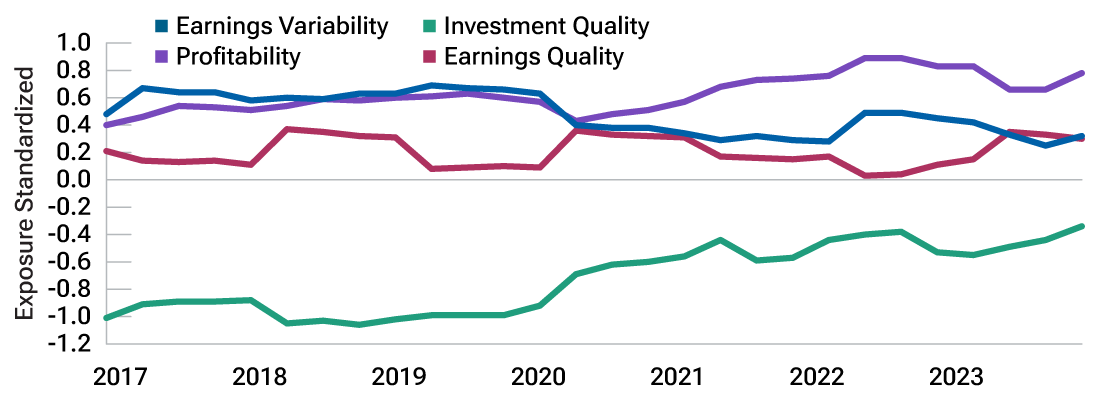
As of December 31, 2023.Calculated using Barra Risk Model (GEMLTL—The Global Equity Model).
The exposure scores represent z‑scores/standardized exposure values. This is done in order for comparability and is standard practice in risk models. A score of “0” implies an exposure equal to that of a the regression‑cap weighted universe. A positive score indicates a score larger and a negative score indicates a score smaller.
Source: MSCI Barra (see Additional Disclosure).
In addition, the earnings quality5 of these firms has witnessed improvement to the upper end of the range in recent quarters as disruptive concepts have evolved into established and more profitable businesses. This evolution has adjusted interest in these types of companies to a broader range of investors, including those seeking qualitative or quantitative quality exposure.
The changing nature of the global economy has been a driving force in the emergence and evolution of digital champions, not as concept, but as dominant in their industries and historically profitable cash flow generators. In many respects, this has reshaped the fundamental characteristics of growth investing, broadening out the opportunity set and economic maturity/profitability of the growth index (Figure 10).
Robust reasons why growth has outperformed value
(Fig. 10) Clear difference in earnings‑per‑share and free cash flow helped drive growth outperformance
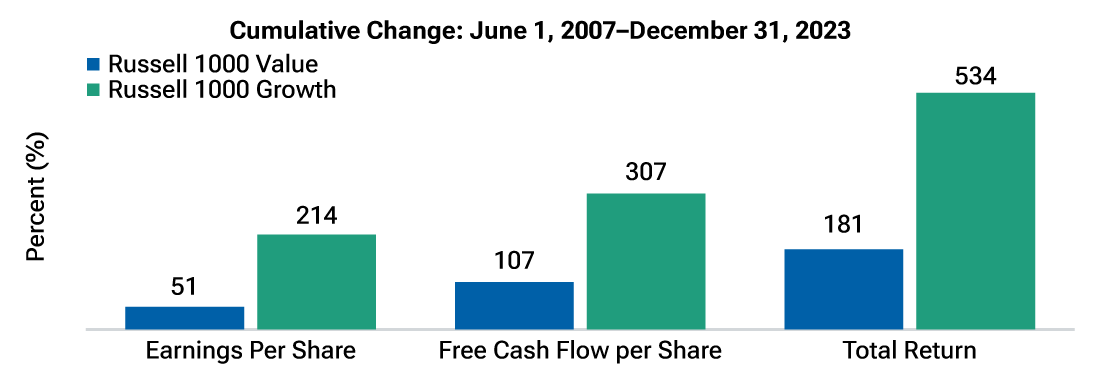
As of December 31, 2023. Trailing 12‑months figures.
Past performance is not a reliable indicator of future performance.
Source: Financial data and analytics provider FactSet. Copyright 2024 FactSet. All Rights Reserved
While the trend of digitization redistributing profits and free cash flow to growth champions has been playing out for many years, an upswing in profitability, coalescing with the beginning of the AI infrastructure cycle, has seen the dimensions of quality evolve. We expect the addition of secular components to become an important part of quality investing going forward, and investors should factor this in to their portfolio construction.
Important Information
This material is being furnished for general informational and/or marketing purposes only. The material does not constitute or undertake to give advice of any nature, including fiduciary investment advice. Prospective investors are recommended to seek independent legal, financial and tax advice before making any investment decision. T. Rowe Price group of companies including T. Rowe Price Associates, Inc. and/or its affiliates receive revenue from T. Rowe Price investment products and services. Past performance is not a reliable indicator of future performance. The value of an investment and any income from it can go down as well as up. Investors may get back less than the amount invested.
The material does not constitute a distribution, an offer, an invitation, a personal or general recommendation or solicitation to sell or buy any securities in any jurisdiction or to conduct any particular investment activity. The material has not been reviewed by any regulatory authority in any jurisdiction.
Information and opinions presented have been obtained or derived from sources believed to be reliable and current; however, we cannot guarantee the sources’ accuracy or completeness. There is no guarantee that any forecasts made will come to pass. The views contained herein are as of the date written and are subject to change without notice; these views may differ from those of other T. Rowe Price group companies and/or associates. Under no circumstances should the material, in whole or in part, be copied or redistributed without consent from T. Rowe Price.
The material is not intended for use by persons in jurisdictions which prohibit or restrict the distribution of the material and in certain countries the material is provided upon specific request. It is not intended for distribution to retail investors in any jurisdiction.
Canada—Issued in Canada by T. Rowe Price (Canada), Inc. T. Rowe Price (Canada), Inc.’s investment management services are only available to Accredited Investors as defined under National Instrument 45-106. T. Rowe Price (Canada), Inc. enters into written delegation agreements with affiliates to provide investment management services.
© 2024 T. Rowe Price. All Rights Reserved. T. ROWE PRICE, INVEST WITH CONFIDENCE, and the Bighorn Sheep design are, collectively and/or apart, trademarks of T. Rowe Price Group, Inc.

